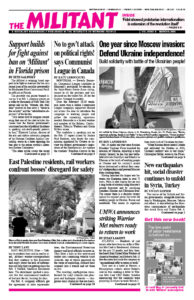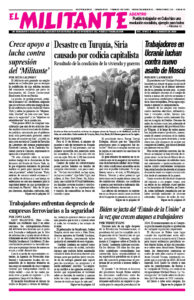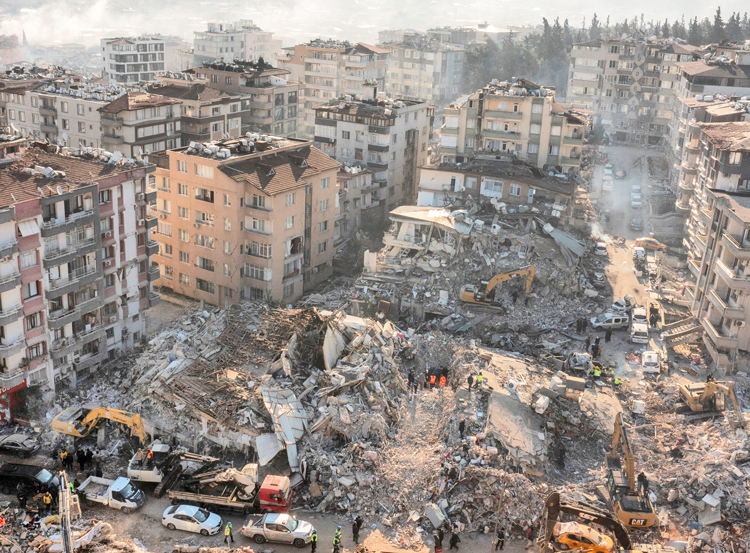The course of the Turkish and Syrian governments, alongside intervention by Washington, Moscow, Tehran and others, is exacerbating the disastrous consequences of earthquakes that struck Syria and Turkey Feb. 6. More than 45,000 people have died as of Feb. 17, making it the worst disaster in the area in modern history.
Another earthquake struck Feb. 20 outside the city of Antakya in southern Turkey, near the Syrian border. At least six people were killed and 294 injured as buildings collapsed in both countries.
An estimated 1 million have been left homeless in Turkey. Many are scrambling for any sort of shelter in the freezing weather, from tents to shipping containers.
In some areas refugees from Syria’s civil war have been barred from tents set up by the Turkish national emergency management agency.
“This is my room for me, my husband and three kids,” Hind Qayduha, a Syrian refugee in Antakya, told the New York Times, pointing to a blanket on the floor of a carwash. With a laugh she pointed to another part of the same blanket, “and there’s my mother’s room.”
The civil war displaced more than half of Syria’s 21 million people, with nearly 4 million ending up as refugees in Turkey, many in the southern area most heavily affected by the quake.
For years Turkish President Recep Tayyip Erdogan used real estate projects to showcase claims that his government was leading a rise in prosperity. In fact, it was letting construction bosses profit while they disregarded the installation of reinforcements that would allow buildings to better withstand devastating tremors.
“We rented this place as an elite place, as a safe place,” Sevil Karaabduloglu told Reuters. His two daughters lie under the rubble of a luxury apartment complex where they lived in southern Turkey. “There is neither cement nor proper iron in it,” said Hamza Alpaslan, whose brother lived in the building for 10 years. “It’s a real hell.”
Half of the 20 million buildings in Turkey contravene building codes aimed at making them more quake resistant.
Erdogan promises to rush through the rebuilding of all houses destroyed in the quake within a single year. The government has no plan on how this can be done. “It is not only necessary to replace the demolished buildings, but also not to build on fault lines,” Esin Koymen, the former head of Istanbul Chamber of Architects, told the media.
Thousands of families in northern Syria have been sleeping outdoors in below-freezing temperatures, lacking even temporary accommodation. Initial estimates say more than 2,276 buildings have collapsed there, though many were already damaged by bombardment from Syrian or Russian government forces. The dictatorial government of President Bashar al-Assad in Syria prevented any international aid from reaching survivors for a week after the earthquake.
Well before the tremor, working people in both countries confronted a deepening economic and social crisis. In Turkey inflation had soared to 57%. In Syria workers and farmers face not only rising prices but also severe fuel shortages. Damascus, the country’s capital, gets a few hours of electricity a day, at best. The country’s capitalist economy has been hit by the collapse of the financial system in neighboring Lebanon and a slowdown in oil shipments from Iran.
Years of foreign intervention
Throughout Syria’s civil war the governments of Iran, Russia, the U.S. and Turkey have deployed forces there to back either the Assad regime or rebel forces, and to carve out influence for their own ruling classes and deal blows to rivals. A half-million people have been killed in the conflict, which began after the Assad regime attempted to crush a popular uprising for political rights in 2011. Moscow’s airstrikes and Tehran-backed militias played a decisive role in propping up his rule.
The U.S. rulers have used the just struggle of the oppressed Kurds in Syria to maintain their forces there and have applied sanctions against Assad. President Joseph Biden refuses to lift these sanctions since the earthquake, but has eased restrictions on financial transactions relating to humanitarian aid for a temporary six-month period.
Six days after the earthquake Washington carried out a helicopter raid in southern Syria Feb. 10 that killed an Islamic State member. Four U.S. troops were injured in a second operation Feb. 16. The U.S. rulers remain the dominant military power throughout the region.
The reactionary bourgeois-clerical regime in Iran continues to arm militias across Syria and uses these forces to funnel weapons to Hezbollah, its ally in Lebanon, and to Hamas in Gaza.
Prior to the quake, Syrian and Turkish defense ministers met in Moscow Dec. 28, the highest-level encounter between the two governments since 2011.
The Turkish rulers have sent forces to back rebel opponents of Assad’s regime. Erdogan wants Assad to prevent the Kurdish People’s Protection Units (YPG) from consolidating their control over an autonomous area in northern Syria. He views the YPG as a threat, fearing their struggle in Syria will amplify struggles by Kurds in Turkey.
Some 30 million Kurds in Iraq, Iran, Syria and Turkey make up the world’s largest nation without their own country.


